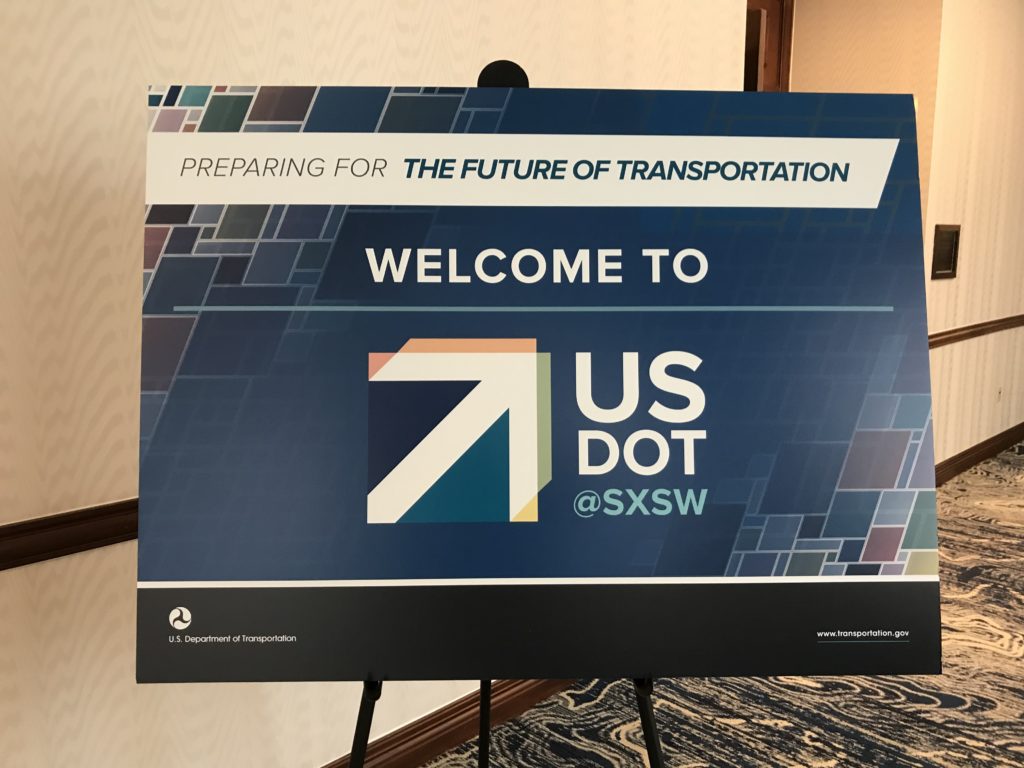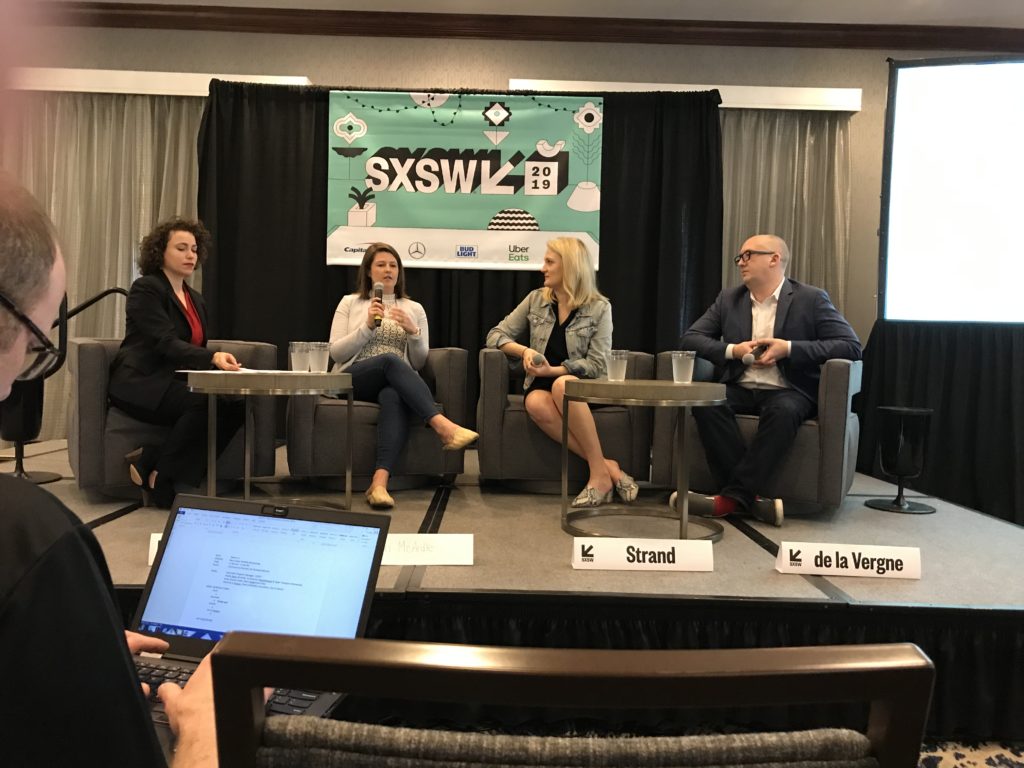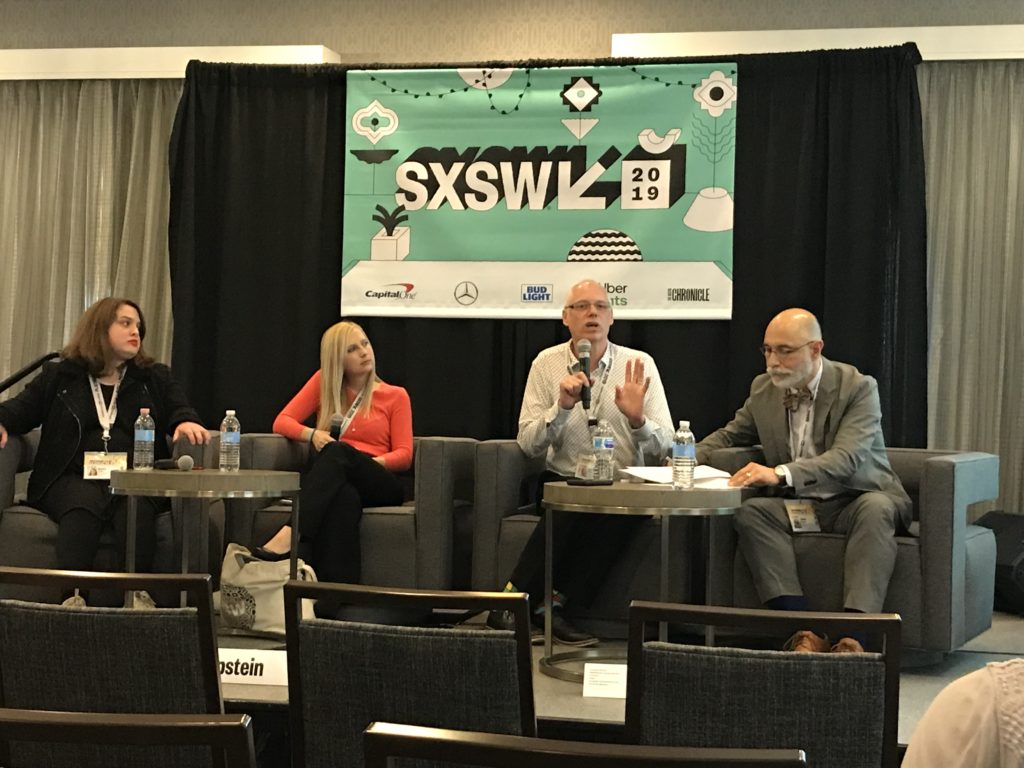
The U.S. Department of Transportation provided two days of programming for SXSW this year. The programming included transportation efforts in urban, rural, autonomous, security, accessibility, and government innovations. In addition to hosting these panels, the DOT featured a demo room showcasing their latest technology innovations. The subject of transportation and technology is getting more and more attention from the private sector as tech companies look for ways to increase efficiencies, be socially-minded, and work towards increased safety for all. Whether it’s sharing valuable data on how scooters are being utilized or creating accessible transportation, the innovations for transportation technology are endless. The three sessions below show a high-level overview of the conversations that were happening at #USDOTatSXSW.
The New Urban Mobility Partnership

The biggest change in urban mobility is increased partnerships between the private sector and government agencies. Companies like Uber and Lyft provide data on a select group of individuals which can help dictate important infrastructure decisions with regards to urban planning. In this session Ariel Gold from DOT moderated this panel featuring Mark de la Vergne from the City of Detroit, Mollie Pelon McArdle from SharedStreets & Open Transport Partnership, and Emily Strand from Uber.
The discussion centered around data and how the data gathered from valuable tech companies, like Uber, use this data to help cities grow their infrastructure and make better decisions for urban planning. de la Verge spoke about this importance for the City of Detroit when they looked at how shared bikes functioned in their city, they used this data to see what made sense when they look at growth and how it helps to sit with people on the private sector so that conversations occur around the data that is being collected from Uber.
Strand focused on the scalability of this data and how the established level of truth needs to be agreed upon so that other cities, states, or countries can view the data the same way. “Creating a global standard and creating standards that can be replicated,” said Strand. There is this opportunity where it is beneficial for cities to have these conversations together and the important part is that everyone is talking about the same data. As the data grows and becomes systematic, Uber can then provide its users with up front disclaimers surrounding how user data is being used and what people can opt out of. Regardless, from Strand’s standpoint, it behooves everyone to be in the conversation from the beginning and to figure out what is a scalable solution.
A question came up from an audience member surrounding how this data is limited to just the users of these apps and means of transportation. It leaves out people who do not have smart phones or utilize shared ride experiences. The due diligence surrounding design for everyone is another topic of conversation. de la Verge spoke to what they focus on in Detroit which is trying to do more human-centered design thinking and making sure conversations are happening with everyone to understand individual challenges. Pelon McArdle commented on the importance of how we all use data, “we have to remember it is not all inclusive.” By focusing on just the data from Uber then design and innovation is continuing to miss out on representing all groups of people.
Accessible Transportation for All

This discussion focused on creating accessible transportation options and what this looks like both in urban and rural areas. Moderated by Vincent Valdes from the DOT, the panel featured Maria Town from the Mayor’s Office For People With Disabilities City Of Houston, Bonnie Epstein from Pinellas Suncoast Transit Authority, and Dr. John Zimmerman from Carnegie Mellon. A very well thought out panel representing urban, rural, and the research side of accessible mobility.
Valdes kicked off the session giving an example of a scenario of someone trying to get around in 2040 and what this looks like. Zimmerman commented on something to consider as we jump 20 years from now, with how urban planning fluctuates as vehicles become more autonomous and what this does to our infrastructure. Zimmerman said, “the amount of infrastructure we devote to idle cars will disappear as we automate and innovate vehicles and transportation.” Seeing the amount of space that gets freed up from cars on the street re-creates our entire infrastructure which can then affect our sidewalks and what accessibility looks like as we look towards more inclusive design.
The need for partnership is key with policy makers and innovators to ensure human-centered design is at the forefront of this conversation. Zimmerman commented on the ideal space for a researcher would be a city where technology and policy could interact through various research pilots. The art of discovery and design that meets everyone’s needs is key in the research space. As Town pointed out though, “people with disabilities, we are natural adapters, we have to be. We ‘hack’ all the time.” The need to look at those innovations being created and more importantly, according to Town, how can people with disabilities become entrepreneurs and make sure all of these innovations are scaled to other cities.
The panel continued with a lively Q&A session from the audience which could have filled its own hour slot. One question that was brought up from an audience member was about how the use of AI would affect the disability community and how can we expect a robot to understand all of the nuances better than a human? Zimmerman chimed in on this to make sure the blame was properly placed. He said, “one of the unexpected outcomes of robots is that they have an infinite amount of patience which humans don’t.” Robots do not rush someone or get annoyed/frustrated when they cannot understand what someone is communicating. Robots have the ability to understand 360-degree space. The biggest point Zimmerman made was about how when the robot does not understand or process someone with disabilities, it’s a choice of the human who made the robot, not a choice the robot made.
Another key moment during the panel came from Town and what she thinks an accessible future should look like.
Step Aside, Cities: Innovations in Rural Mobility

The final session of the day focused on rural mobility and what this means to the majority of the country. Moderated by Elina Zlotchenko from the DOT, the panel featured Dia Gainor from National Association of State EMS Officials, Gabe Gutierrez from the Wyoming DOT, and federal policy manager from Lyft, Jake Swanton.
Zlotchenko opened the discussion with the need to address rural communities and this is a potential market failure if we do not have these discussions. Each panelist brought their viewpoint. Gutierrez kicked off the discussion from his viewpoint with the success they are having in Wyoming with the connected vehicles testing. Wyoming was one of the few states selected for connected vehicles by using the I-80 corridor. The issues they face now are the limited available communication infrastructures.
Swanton’s standpoint with Lyft in rural areas is two-fold, there is the need for driver demand in order to meet consumer demand. They’ve been innovative around this by rolling out a scheduled ride option for rural communities and this option best serves both the driver and the rider. The issue which was brought up by Guitierrez and by audience members as well is what happens to those without smart phones or poor cell phone service in remote areas of Wyoming and how are they being served? Swanton did mention there is a 1-800 number to call and a Lyft can be dispatched this way if you do not have a smart phone or enough data to connect to the app.
Gainor talked about what better connectivity and AI means for the EMS and what sort of gamechanger this would look like. It gives the ability to receive real time data and information throughs advanced automatic notifications of crashes or incidents. When EMTs or paramedics are trying to get onsite, time is wasted due to not only getting their but then making sure the person injured is getting taken to the proper care facility. Later in the session, Gainor talked about how this keeps her up night as well.
A larger issue that is surfaced through the discussion of rural mobility comes from the need for funding. While the state of Wyoming received a grant to conduct the connected vehicle pilot, other areas may not be as fortunate and therefore continuously underserved. Swanton talked about the need to partner with private sector businesses for creative funding options, but for Lyft, tapping into the rural market is still a work in progress.
Increased partnerships with the private sector, research, disability advocates, policy-makers, and technology make the transportation and mobility sectors a layered space for innovation. Ensuring human-centered design is key when looking ahead and always thinking about what the needs of all users in all areas.

Comments are closed, but trackbacks and pingbacks are open.